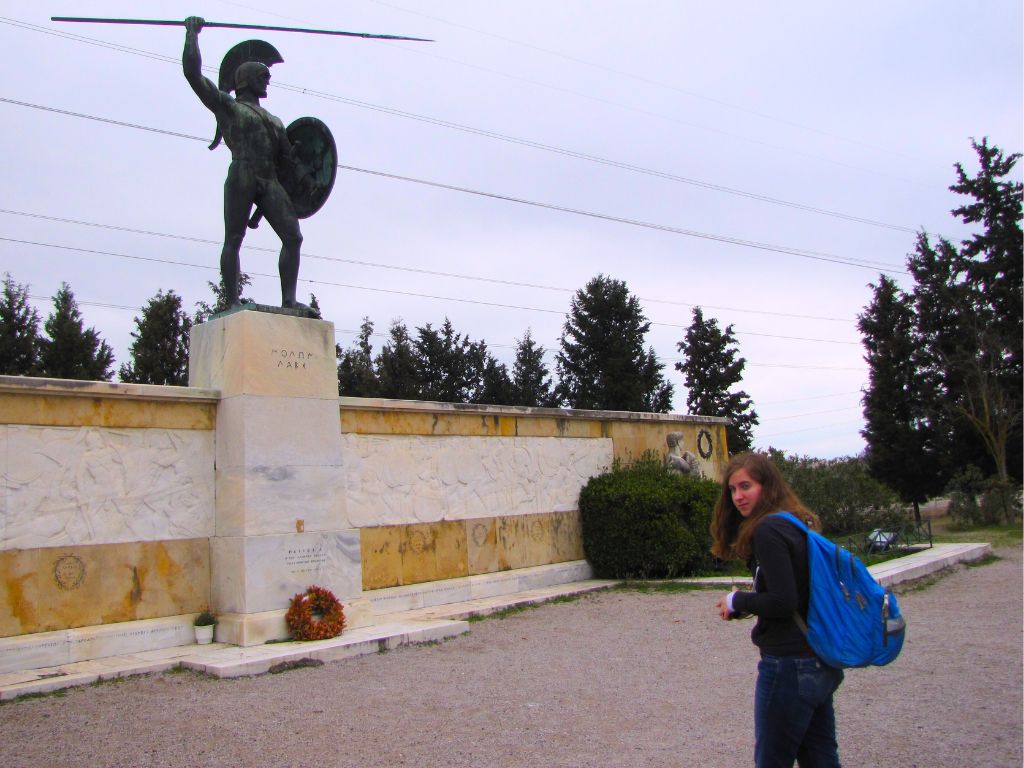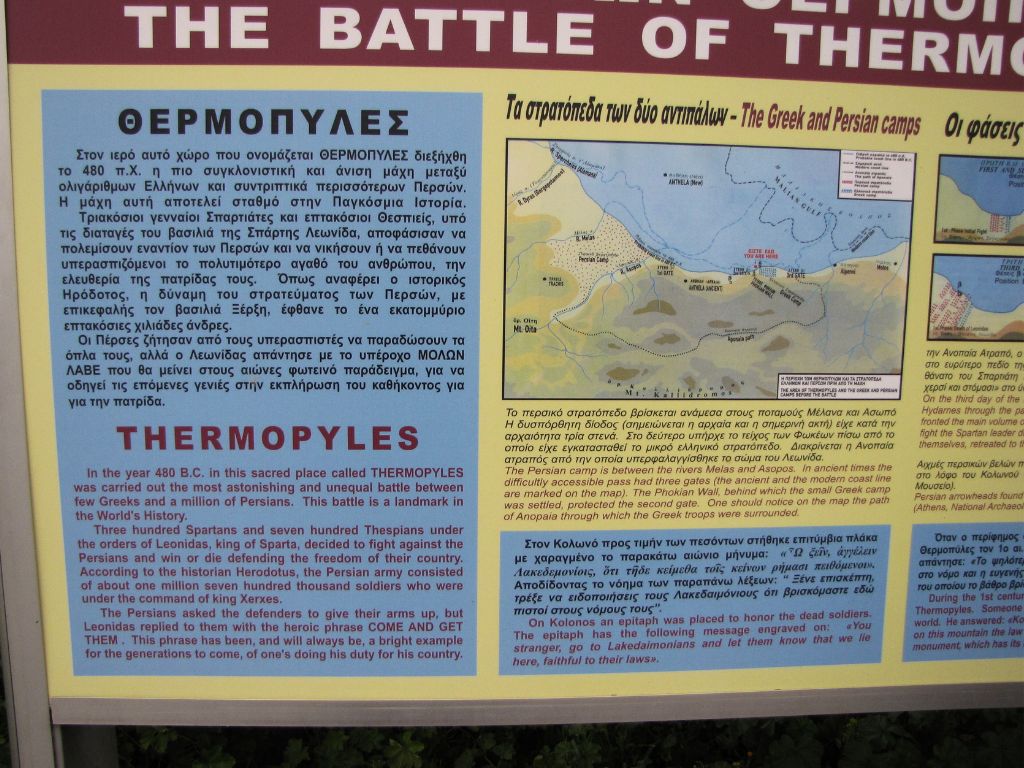As we drove towards Thermopylae, we listened to Costos Tsevas, our tour guide. Soon we understood the importance of 4 days delay.
With an army of 1 million 700 thousand soldiers, escorted by an enormously big navy of 1 thousand and 400 ships (the world had never seen such an army nor such a navy) Xerses crossed the Bosporus and marched towards Athens through Thrace, Macedonia and Thessaly – making all the Greeks of the south scared to death. The only place the Greeks could stop Xerses, for a while, was at the pass of Thermopylae because there his army couldn’t be helped by his navy.
The Greeks gathered at the pass, a place close to some thermals (hot springs called Hot Gates) very close to Mount Kallidromo, where the road narrowed like a funnel into a very narrow strait where only chariots could go through. 5000 Greek soldiers from different city states from the south, came to Thermopylae to be led by the King of Sparta, Leonidas, and his 300 men. Together they built a wall and completely blocked the straits.
When Xerxes arrived, it took two days for him to realize that he couldn’t go through it with all his army and all his heavy equipment, enormously big equipment, unless he could kick the Greeks out from there.
As seen in the movie 300, Xerxes found a local shepherd, Ephialtes, who knew the area very well. Xerses gave him gold. The shepherd showed Xerses’ personal garrison, the Immortals (the most important part of Xerses’ army) an alternate mountain path, the path of Anopaia, which led to the rear of the Greek troops.
The Immortals, led by Ephialtes the traitor, started marching this mountainous path at dusk. The next day at dawn, they were at the top of the mount. The rising sun flashed on their bronze shields. The Greeks, from the foot of the mount, realized that the Persians now were above their heads.
Leonidas called to the Greeks, “You know, we are betrayed. After a while more Persians will be coming behind them. So, for that reason, go away, as there is still time for you. Go back to your homes and defend your homeland. But, me and my soldiers, we are going to stay because the Law of Sparta doesn’t allow us to leave the battlefield unless we are dead or winners.”

When Leonidas made that announcement 700 men from another little city close to Thebes, called Thespiae, appeared to Leonidas. They told him, “Look if you have decided to stay here with your men to die, we are going to do the same with you.” So, 300 Spartans and 700 Thesbians, under the King of Sparta (Leonidas) built another wall and blocked themselves in among these two walls. But by noon they were surrounded.
Xerxes sent a delegation to Leonidas asking for their weapons, the sign of surrender – also offering to Leonidas, and his soldiers, positions in his army. The answer from Leonidas was, “Having come, take them.”
The delegation came back once more, warning Leonidas, “Be reasonable. If every soldier throws only one arrow, it’s going to form above your heads, a cloud of arrows.”
Leonida’s answer was, “That’s better, because we are going to fight in the shade.”
That afternoon the Greek soldiers prepared a festival, like a wedding reception, celebrating their last day on earth and their departure to Hades. The next day the battle lasted less than two hours. They were all dead.
Xerxes went through the straits of Thermopylae – with four days’ delay. These four days were enough time for the city of Athens to be evacuated.
When Xerses arrived in Athens the city was empty. The city of Athens had been evacuated by the Athenians with their ships. With 85 ships they brought all the population to the Greek Islands.
But Xerses levelled the city. Then, when everything seemed to be over, forever, in Athens, the Persian navy made a fatal mistake. The Persian Admirals thought the shortest way from Athens to Corinth was through the Straits of the Island of Salamis. But, the Island of Salamis is very close to the mainland forming the straits. They entered to pass through the narrow strait with this enormously huge navy which also had responsibility for the food supplies for the Persian army.
The Greek navy of 120 ships, (85 of the ships were Athenian ships coming back from the evacuation of the city) divided into two groups and blocked the two exits of the straits. The Persians, under panic, started crashing upon their own ships. In their efforts to maneuver they destroyed their own navy which they left their army without food supplies.
Xerxes left Athens and went back home. The historians say that when Xerses returned from Greece, he married Queen Esther (described in the Book of Esther, in the Old Testament.)
The next year the Athenians came back in Athens, reconstructed the city and their political system (democracy.) That marks the beginning of the Golden Age of Athens – the Golden Age of the Athenian Democracy and the culture of democracy, as called by the Romans, Classical Culture.
This is why the Battle of Thermopolis is so important for the Western Culture. If Xerxes had quickly gotten to the people of Athens and into the city, the people would all have been captives or dead and then we never would have had the time of democracy and the classical culture, which prepared the time of the New Testament.
After the Persians left Thermopylae, the local people gathered the dead bodies of the soldiers and the king to the place of their last stand of resistance at the top of a hill called Kolonos, Greece, which was a little peninsulate at that time. They cremated and buried them there.
Some years later after the Persian wars, Athenians, remembering their sacrifice, gave them a poem, an opportunity to survive/to be remembered, saying “Come HERE and put a little poem.” The poem engraved on the gravestone says, “Hey you stranger, go down to Laconia, to Sparta, and tell them that we are buried here in obedience to their laws.”
When we arrived at Thermopylae Kostas pointed out a roadside marker, an historical map of the battlefield.


I imagined water being next to the mountain, as it used to be. We stood in an area that, at the time of Xerses and Leonidas, was the sea. We saw the modern coastline of today and the coastline at the time of the battle.
We are here and just beside here is this short hill, behind the bushes and the trees, called Kolonos. This is the Greek town, and this is the Persian camp on the other side there. The mountainous path was here and leads to the back of the graves. The mountainous path was at the very top of the ridge there, during the dawn the Persian immortals were up there and the sun rising from this direction was flashing on their shields. So, the Greek camp that was just behind this hill at the straits saw the bronze flashing shields up there and realized that the Persians were coming to their camp.
Three hundred Spartans and seven hundred Thespians under the orders of Leonidas, king of Sparta, decided to fight against the Persians and win or die defending the freedom of their country. According to the historian Herodotus, the Persian army consisted of about one million seven hundred thousand soldiers who were under the command of King Xerxes.
During the 1st century A.D., the philosopher Apollonios Tyanefs visited Thermopyles. Someone asked him which was the highest mountain in the world. He answered: Kolonos is the highest mountain in the world, because on this mountain the law keeping, and the noble self-sacrifice, have put up a monument, which has its base on the earth and reaches the stars.
Thoughtfully we left the map and walked toward the sights of Thermopylae, the monument of Leonidas and the grave on the hill.
